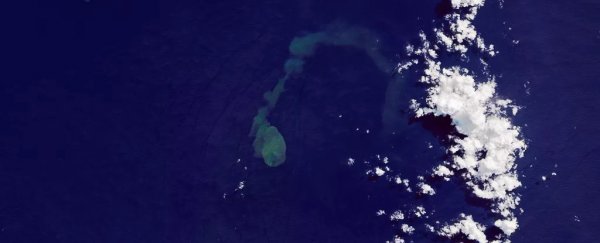Kavachi Volcano, an active submarine volcano in the Solomon Islands, has long been home to sharks. However their once-peaceful playground in the southwest Pacific Ocean recently became a bit less serene.
In recent months, NASA satellite images detected plumes of discolored water over the volcano – tell-tale signs of volcanic activity, hinting at multiple eruptions. The images were captured by the Operational Land Imager-2 (OLI-2) onboard the Landsat-9 satellite, according to the Smithsonian Global Volcanism Program.
NASA's Goddard Space Flight Center in Greenbelt, Maryland, shared the news over the weekend in a tweet that read, "You've heard of sharknado, now get ready for sharkcano."
🦈 You’ve heard of sharknado, now get ready for sharkcano.
— NASA Goddard (@NASAGoddard) May 22, 2022
The Kavachi Volcano in the Solomon Islands is home to two species of sharks. It’s also one of the most active submarine volcanoes in the Pacific, seen here erupting underwater by #Landsat 9.https://t.co/OoQU5hGWXQ pic.twitter.com/vEdRypzlgi
The tweet also mentioned that Kavachi happens to be "one of the most active submarine volcanoes in the Pacific."
Related: Underwater volcano in Antarctica triggers 85,000 earthquakes
Researchers noticed changes in water color over the volcano in April and May, and the volcano likely began erupting as early as last October, according to a statement released by NASA's Earth Observatory. Prior to that, its most recent large eruptions took place in 2014 and 2007. (Records indicate that Kavachi's first recorded eruption occurred in 1939, with subsequent explosions creating ephemeral islands.)
Prior research conducted by the National Oceanic and Atmospheric Administration (NOAA) found that the volcano's plumes of warm, acidic water typically contain particulate matter, volcanic rock fragments and sulfur, the latter of which "attracts microbial communities that thrive on sulfur."
During a 2015 research expedition to Kavachi, scientists were surprised to discover that the volcano's crater also happens to be home to two types of sharks – hammerheads and silky sharks – despite the locale's turbulent history.
In a 2016 article in the journal Oceanography titled "Exploring the Sharkcano", researchers wrote that the presence of sharks in the crater raised "new questions about the ecology of active submarine volcanoes and the extreme environments in which large marine animals exist."
Kavachi's summit lies approximately 65 feet (20 meters) below sea level, with its base spreading across the seafloor at a depth of 0.75 miles (1.2 kilometers). The volcano is located approximately 15 miles (24 km) south of Vangunu Island, one of more than 900 islands that were formed in a tectonically active area and make up the Solomon Islands archipelago.
Residents of neighboring islands have reported that they regularly see steam and ash on the water's surface, further confirming that the so-called sharkcano is percolating beneath the surface.
Related Stories:
10 times volcanoes blew our minds in 2021
Dramatic photos show horrific aftermath of massive Tonga eruption and tsunami
10 of the deadliest natural disasters in history
This article was originally published by Live Science. Read the original article here.
